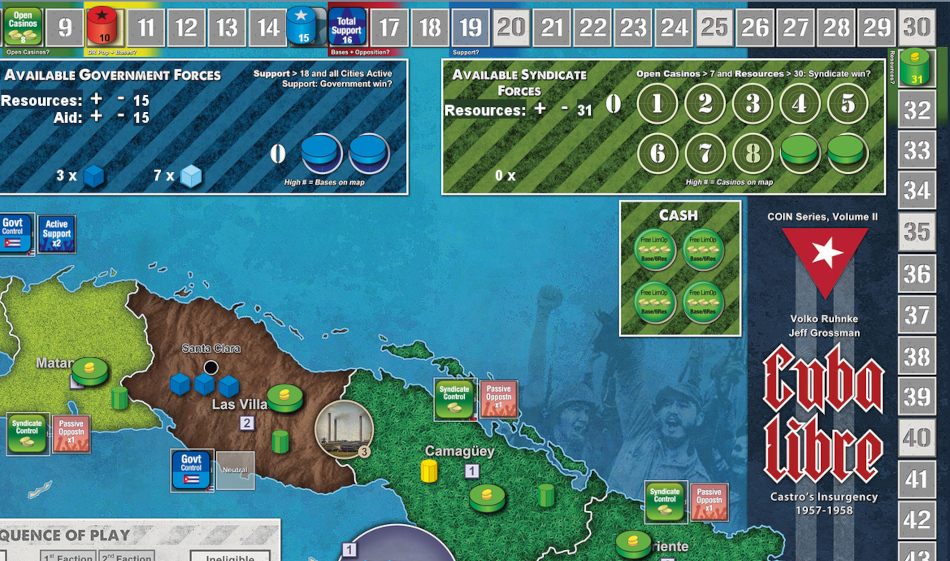This Conflicts of Interest Online post is from SDHistCon COI Online editor Andrew Bucholtz. This is the first installment in an intended occasional series covering GMT Games’ COIN series, and its commonalities and divides across factions. Amongst his other historical gaming interests, Andrew has been playing and teaching COIN games for much of the last decade. He can be contacted on Twitter @AndrewBucholtz, or via email at andrew_bucholtz at hotmail.com.

SD HistCon COI Online editor Andrew Bucholtz.
The GMT Games COIN, or counterinsurgency, series began with the 2012 publication of Andean Abyss, a game by series creator Volko Ruhnke looking at the drug war in 1990s Colombia. Ten additional standalone volumes (and one multipack) have been published to date, covering everything from Gallic revolts against Caesar to the American Revolution to 21st-century Afghanistan conflicts, and several further volumes are on their way. Each game is quite different, but they have some overlying similarities: asymmetric factions (four in most titles, three in All Bridges Burning and People Power, two in Colonial Twilight and The British Way) that use operations or commands (which usually cost resources), special activities or feats (which usually are free), and event cards to work towards their particular and unique victory conditions.
The series has a significant level of rules, concepts, and even faction operations and goals that carry over from title to title. But there are notable game-to-game changes to map each title more closely to the particular conflict in question than a purely generic framework would. Exploring seemingly-similar factions’ commonalities and differences can tell us a lot about individual games and the wider series. And a good place to start there is with economic-focused factions.
Resources matter for everyone in the COIN series, but they matter even more for economic-focused factions. Those are defined here as a faction who requires a certain level of resources for at least one of its victory conditions. Of the COIN titles published to date, five games have factions whose victory conditions include having a certain level of resources, with six factions in total meeting that criteria. That would be Andean Abyss‘ Cartels, Cuba Libre‘s Syndicate, A Distant Plain‘s Warlords, All Bridges Burning‘s Moderates, and Pendragon‘s Saxons and Scotti. For all of them, the money does talk.
Of course, some of these factions are not as “economic-focused” as others. For example, Pendragon’s Saxons have one way to win regardless of resource levels. And there are also some factions not mentioned here where economic activity is a key part of their gameplay, but not a specific part of their victory conditions. Falling Sky’s Aedui in particular come to mind there.
There are other economic-adjacent conditions, too, such as the patronage levels Fire In The Lake’s ARVN and A Distant Plain’s Government are seeking and the island prosperity Pendragon’s Dux care about (which will be discussed further later). But those don’t specifically come from the resources used for operations. Thus, the six factions listed above do represent a distinct group, one where resources are key to not just their operations, but their victory. And exploring their similarities and differences can tell us a lot about these games, and about what the designers of each volume are looking to represent with “resources.”
The two of those factions with perhaps the most commonality are Andean Abyss’ Cartels and A Distant Plain’s Warlords. They’re both using the green pieces, they’re both thematically involved with drug production, and they’re both targeting 41 or more resources to win (albeit with 11 or more bases for the Cartels and 16 or more uncontrolled population for the Warlords). They’re both picking from Rally, March, Attack, and Terror operations, with those operations generally working similarly (the Warlords have a Rally limitation around Pashtun spaces). And they both have a Cultivate special activity that works similarly to add bases. The Warlords’ Suborn special activity works similarly to the Cartels’ Bribe, too, albeit with a cheaper cost but less effectiveness against fellow insurgents.
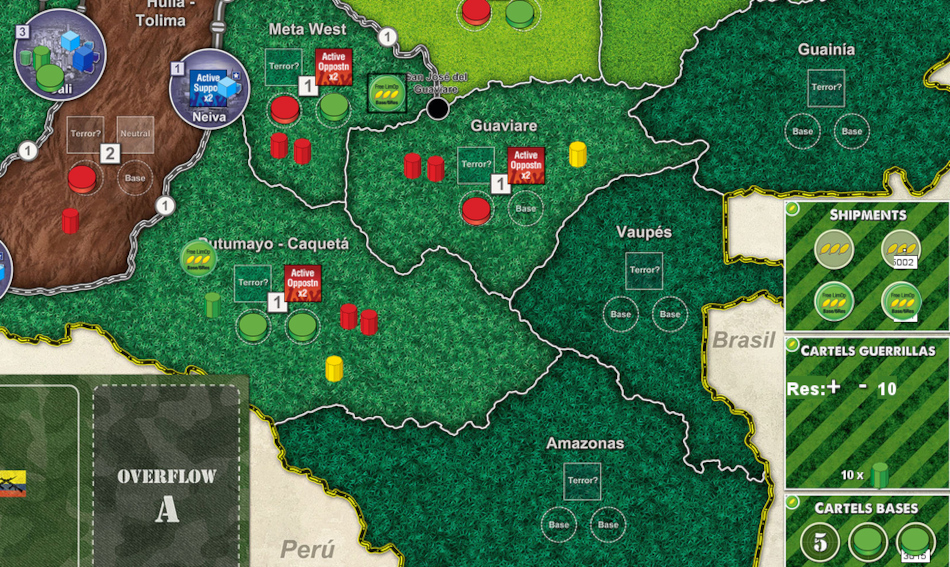
Some bases and Shipments for Andean Abyss‘ Cartels. (VASSAL.)
But one major difference between these factions is how they get resources in propaganda rounds, which also ties into their allegiances. For Andean Abyss’ Cartels, it’s simply about the bases; they receive make three times the number of their bases in resources. For A Distant Plain‘s Warlords, there’s encouragement to maintain the economy; they get one resource for each of their bases, plus one for each guerrilla on an unsabotaged line of communication (which also benefits the Government player’s resources). Thus, while the Warlords are enemy to their game’s Government faction (and also the Coalition and the Taliban factions), just as the Cartels are to their game’s Government faction (and also to its FARC and AUC factions), there’s some economic crossover for the Warlords and A Distant Plain‘s Government that the Coalition-Government relationship in Andean Abyss doesn’t have.
Another key difference is the Cartels’ Process special activity, which doesn’t have a Warlords analogue. This puts shipment markers on the map, which can change hands (by deals or violence), can be used for free limited operations, and can provide a resource boost in propaganda rounds. And that works almost identically to the profit special activity and the cash markers that Cuba Libre’s Syndicate uses.
Cuba Libre‘s Syndicate also Marches and Bribes like Andean Abyss‘ Cartels, but it has notable other differences. It doesn’t have an Attack operation, it can’t place bases by Rallying (instead, it has a unique Construct operation that uses five resources rather than removing two guerrillas), it has two-step bases (closed and open casinos), and it has the Muscle special activity to bring Government troops and police to protect casinos. All Cuba Libre factions are enemy to each other faction, but the Syndicate has no Attack operation, so it can only remove enemy pieces with Bribe or with events. It isn’t regularly attacking the other factions. And it also has some ability to relocate Government forces with Muscle to protect its casinos.

Starting Syndicate Casinos in Cuba Libre. (VASSAL.)
The way resources work for the Syndicate in the propaganda phase differs from those above-discussed factions, too. They gain twice the number of open casinos, plus the population of cities and unsabotaged economic centers where their guerrillas outnumber police (with the latter having some crossover to the aforementioned Warlords). Thus, they have incentive to get their guerrillas on the map. But their resources get skimmed by other factions that control spaces with open casinos. This provides incentive for other factions to control Syndicate areas.
With all these challenges for the Syndicate, from expensive and two-step bases to skimming opponents, it’s perhaps not surprising that their victory condition is lower than A Distant Plain‘s Warlords or Andean Abyss‘ Cartels. They need only eight or more open casinos and 31 or more resources, a condition seen as fulfilled in the image at the top of this post. And while all economic-focused factions can sometimes get surprising wins if left unchecked, this maybe happens even more with the Syndicate with their lower targets.
All Bridges Burning’s Moderates work quite differently than the factions described so far. But they do have some crossover to Cuba Libre‘s Syndicate in being unable to Attack, and to the Syndicate and Andean Abyss‘ Cartels with news markers. Those have some similarities to cash or shipment markers. The Moderates’ Senate and Reds opponents can capture that news and use it for free limited commands. For the Moderates themselves, they have to get that news to their personality (via their unique Message command), who can then use it with their Publish special activity to further boost their resources or reduce polarization.
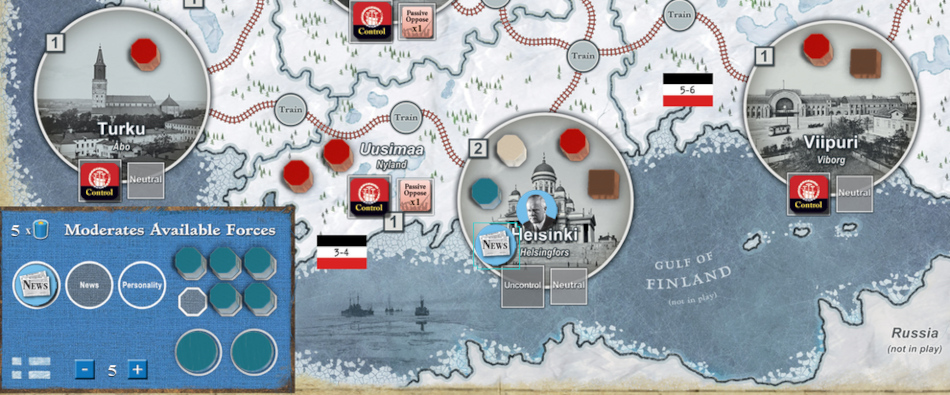
An image of All Bridges Burning, showing a Moderates cell, their Personality, and a News marker in Helsinki. (VASSAL.)
The polarization is a unique feature of All Bridges Burning. It determines the Moderates’ resource gains during propaganda rounds, with more polarization equaling more resources). But to win, they need not just to have 15 or more resources, they need polarization to be lower than their networks (bases) plus the number of resolved issues. And both of their opponents have incentives and disincentives to reduce polarization or resolve issues. So while the Moderates have some things in common with other titles’ economic-focused factions, much of what they’re doing is unique not just amongst these factions, but unique in the COIN series as a whole.
Speaking of unique, Pendragon is perhaps the COIN title that differs the most from the series as a whole. And that also applies to its economic-focused factions. In fact, at first glance, its factions might not even seem to fit this list. The Saxons and Scotti have more in common with the more military-focused insurgent factions than anyone else on this list here, and they primarily get resources in a much different way (Raiding to turn prosperity into plunder, then Returning with that loot and transferring it to renown).
But the Scotti need resources (renown) to win (46 or more, plus at least four settlements), and the Saxons need renown for one of their two win conditions (30 or more before fragmentation, plus at least four settlements). The Saxons’ other potential win condition (population under Saxon control of 11 or more) reflects a goal of settlement rather than plunder, which became more important for them in the later eras depicted in Pendragon. But until that point, their only way to win involves resources. And plunder and how it’s transferred has some crossover to shipments, cash, and news.
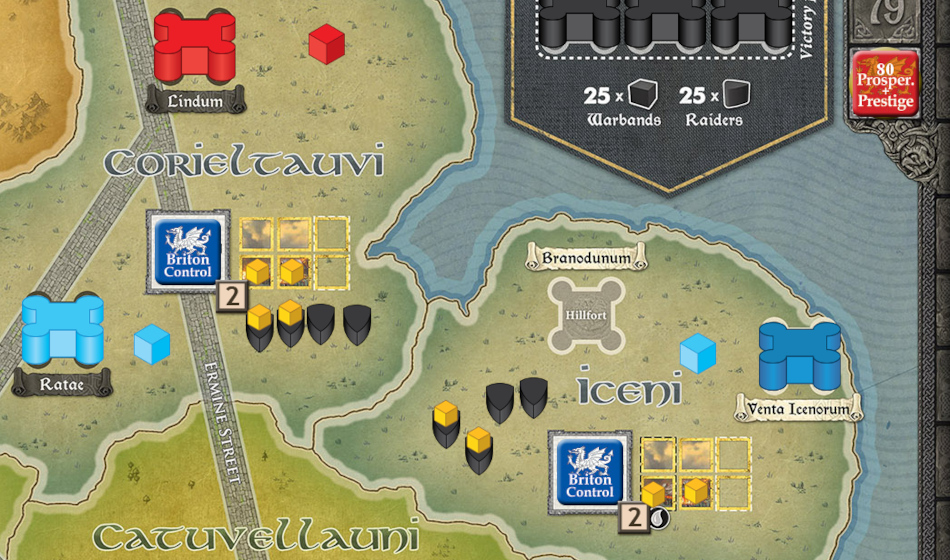
Saxon raiders in Pendragon coming for island prosperity. (VASSAL.)
Pendragon is also worth discussion for the Dux, who perhaps come the closest of any title’s COIN faction to “economic-focused.” They don’t quite get there, as their victory conditions care about island prosperity and their own prestige (two separate tracks) rather than the resources they’re actually spending for operations. But island prosperity is crucial for them. For victory, they need it to be at least 76 if the Imperium status is still Roman Rule, or at least 61 if it’s Autonomy (they also need military dominance in either case). And they only go away from caring about prosperity if the Imperium status hits Fragmentation.
And much of a Pendragon game sees the Dux in a direct battle with the Saxons and Scotti over prosperity. And from battles and events, the Dux have opportunities to boost both prosperity and prestige. Their Retaliate Feat is worth a specific note, as it lets them gain plunder and prestige in battle and also reduce the opponent’s Renown or Wealth, thus impacting the resources and victory conditions of both factions.
Meanwhile, Pendragon‘s Civitates also care about resources. For much of the game, at least until fragmentation, they’re sharing resources for commands with the Dux, and their Trade command can mean they’re generating many of those resources on their turns. (This is similar to Falling Sky‘s Aedui, who also emphasize Trade and often need to fund Roman military operations.) The Civitates are also concerned with transferring resources to their own private wealth, which is crucial to getting their special Comitates forces on the map and establishing the civilian dominance they need to win.
But the Civitates’ actual win condition is about the population under Briton control, rather than resources. So wealth (and its relative status next to Dux prestige, which determines shifts from military to civilian dominance and vice versa) is a means to set them up for a potential victory rather than an actual component of that victory check. And while wealth can be spent for commands like resources if needed, that’s generally not desirable for the Civitates, so that further separates them from the economic-focused factions primarily discussed here, where the victory checks are concerned with the resources spent for operations or commands.
The aforementioned patronage for A Distant Plain’s Government and Fire In The Lake’s ARVN deserves a mention here as well. These are both COIN factions, but their patronage goals are similar to the goals for the insurgent economic-focused factions primarily discussed above. As with Pendragon’s Dux and their island prosperity and prestige, patronage in these games is a resource (or at the least, a track) that matters for victory conditions, even if it’s not one that can be typically spent. And the patronage here has a lot of crossover to Pendragon‘s Civitates’ wealth in how it’s obtained and what it means.
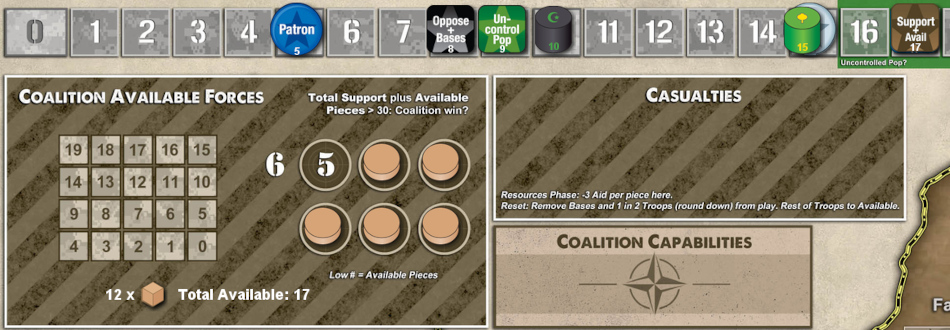
Starting patronage for the Government in A Distant Plain. (VASSAL.)
In A Distant Plain, too, two of the ways to boost patronage are linked to resources. The Eradicate special activity wipes out rural Warlord bases and boosts patronage and also aid (and Aid provides the Government actual resources during propaganda rounds), but does so at the cost of increasing opposition. The Govern special activity can boost Patronage, but that comes at the cost of lowering aid, and at the opportunity cost of opting not to use its other option to resettle refugees. In Fire in the Lake, the ARVN have a similar Govern special activity that can either boost Aid (and thus, boost ARVN resource gain during coup rounds), or transfer Aid into Patronage. So while the A Distant Plain government and Fire in the Lake ARVN don’t quite meet the strict “economic-focused factions” definition above, they’re still factions who are quite concerned with a track adjacent to and related to resources.
For each of these factions across the series, resources mean something slightly different. In the cases of Pendragon’s Saxons and Scotti, their resources are renown, or fame. This is used to build forces, and while that’s done through raids and die rolls rather than Rally commands, there’s an argument that the fame is rallying people to the cause. And for the Saxons, that becomes less important later in the game thanks to that shift to a settlement focus.
The renown in Pendragon has perhaps more crossover to the politically-motivated insurgents in other titles than it does to the resources held by the Syndicate, Cartels, and Warlords. Those factions are presumably offering their guerrillas more material considerations. However, the Saxon and Scotti Raid recruitment rolls represent promises of material plunder, not just fame. And the segmentation of their Stronghold (base equivalent) construction into a feat (an equivalent of special activities in many COIN titles) rather than as part of their Raid command indicates their need for material goods as well.
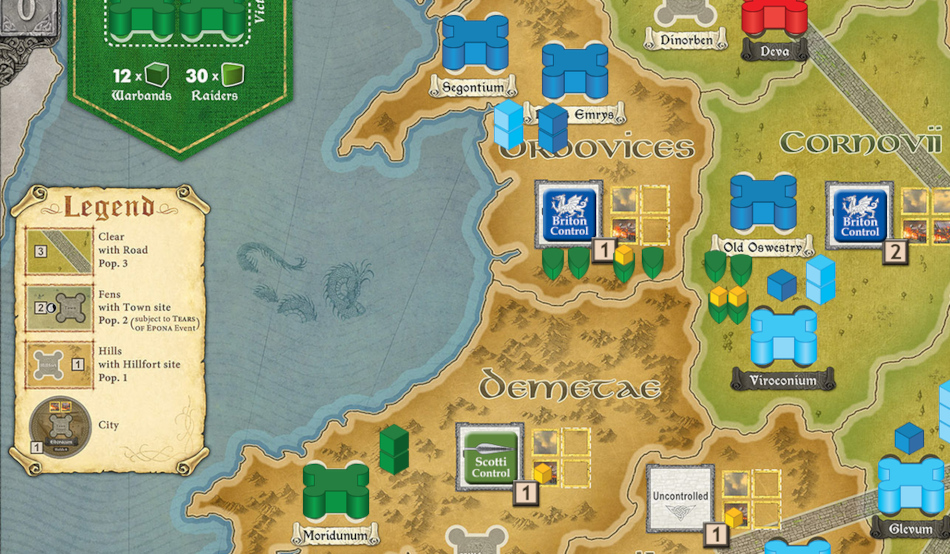
A late-game Scotti raid in Pendragon, from their Stronghold in Demetae. (VASSAL.)
In All Bridges Burning, resources represent political capital or political will rather than material considerations. And that makes logical sense, as the moderates are maybe the most politically-motivated of these economically-focused factions. Even accumulating that political capital is only one part of their concerns, as they’re also looking to resolve issues and reduce polarization. The use of “news” as the shipments/cash analogue here also reinforces the emphasis on political will, not material resources, and the Publish special activity is a key way for them to gain resources during a campaign (with or without a news marker), adding to the sense that the resources here are about will rather than material goods. But it’s interesting that the “news” markers in All Bridges Burning have some gameplay crossover with how drugs and cash are handled in other titles.
Cuba Libre’s Syndicate, Andean Abyss’ Cartels, and A Distant Plain’s Warlords have the most crossover of all of these factions, and resources represent actual money and materials for all of them. They’re all involved in illicit activities of some sort as well. But even there, their differences are notable, with the Syndicate able to more directly move government police and troops (but less able to openly battle rivals), and with the Warlords caring about population control as well as money. And their commonalities and differences to all of the above factions tell us a lot about how resources are treated in each game, and to what that says about the individual designers’ perspectives on the key resources in the conflict they’re representing.
While these six economic-focused factions across five titles are distinct in many ways, there’s one critical commonality between them. For each of these factions, part of their victory goal comes from the same resources they use for operations. Every faction in COIN titles needs resources to conduct operations, and most factions have to not just monitor their current spending, but also consider how to maximize their income ahead of future rounds. But both of those considerations become perhaps more important still for these six economic-focused factions. Whether representing political will, raiding renown, or more material resources, these factions’ resource tracks aren’t just a means towards winning the game. For those factions, the status of those tracks helps determine if they will ultimately emerge triumphant or not. So for them, money really does talk.
